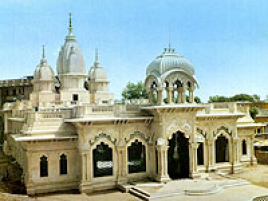Holy God! Discovering Hare Krishna-ism in Vrindaban, India
By Dave Norman | May 08, 2010

Their morning starts at 4:30, with someone at the temple whacking a brass gong with a wooden mallet and entirely too much enthusiasm given the hour. Then the singing starts. Somewhere out in the fog a woman’s voice rises above a din of car noise and gongs and chanting, her enthusiasm and their enthusiasm and the mist entwined with ethereal embrace. It would be beautiful, if it didn’t jar me awake.
Their mantra is simple, the same song over and over: “Hare Krishna, Hare Krishna, Krishna Krishna, Hare Hare, Hare Rama, Hare Rama, Rama Rama, Hare Hare.” And, repeat. Again. For hours. It essentially means “Holy God,” and “Holy Spirit,” and is pretty effective at getting stuck in your head and staying there for an impressively long time.
Krishna Consciousness
Which is part of the goal of “Krishna Consciousness,” the heart of the Hare Krishna movement and the entire reason for the facility where we’re staying. Founded by Swami Prabhupada, guru to members of the Beatles, his project “is designed to safeguard the continuous service to the deities, even in times of economic trouble.” The complex has a guesthouse: eight apartment buildings interspersed with gardens and reflecting pools, and the adjacent temple with its various deities and ornate marble construction. Tall orange walls topped with barbed wire and wrought-iron spikes separate us from the real Vrindaban. Within the sanctity of these hallowed grounds, Hare Krishnas practice their form of spiritual tunnel vision.
Prabhupada’s Krishna Consciousness is essentially the denial of physical and mental distractions to afford a focused, continuous awareness of God, His role in life, and His presence all around; the catchy song that gets so easily stuck in the head is a step in the right direction. Giving up your worldly possessions, turning your back on your family and entering completely into the service of the Hare Krishna movement, is the ultimate goal.
We’re staying here because it’s clean, otherwise peaceful, and disinterested men with ancient shotguns guard us. With tidy grounds and manicured hedges, cleaning services and a Western-stomach-friendly restaurant upstairs, this is the place where Dr. Gupta puts all his foreign students.
Alarm clock
And so the Hare Krishnas’ sacred morning routine will be my alarm clock until I learn how to sleep through it. It begins with that clanging, builds with their voices, and culminates in the blowing of conch shells that sound like foghorns on oil tankers — given the fog, it fits.
Just as the near temple quietens down for the morning, a far temple picks it up, as they “wake the deities” in their shrines. Each shrine holds a statue — a term that offends Hindus — that represents Lord Krishna, or Shiva, or any of the other countless manifestations of Vishnu, the original source of all life and matter. Where Christians say that God is the Lord of the Poor, the Lord of the Humble, the Savior of the Weak, etc., the Hindus have a specific name (and physical representation) for each of those facets of the one divine being, which leads to a lot of misunderstanding, and a canon full of more deities than even the most ardent Hindu can keep track of.
In every temple is a statue of one particular facet of God, and the statue is worshipped in what much of the rest of the world calls idolatry. Within the Hindu faith, though, the statues actually come to embody the presence of God.
The life of a statue
Each statue is carved from stone, usually marble; never plastic. Each is then submerged in various baths, each bath for seven days, while devotees continuously chant mantras and praises. The baths include submerging in milk, rice, wheat flour, ghee (clarified butter), salt, etc. The consecration process culminates with the dressing of the deity in the finest deity-sized clothes, and installation in the temple’s shrine.
Every morning it is “woken up” with chanting and singing.
Every morning it is “woken up” with chanting and singing, the blowing of the conch shell, and the banging of gongs. Then the deities are given offerings of food (from the breakfast prepared for the devotees, or simply puffed rice), wind (from peacock feathers), fire (incense), etc., in a ceremony that is to bring blessing to the devotees and to their use of the five natural elements.
In the evening the deities are chanted to sleep, with a curtain drawn over their shrine for modesty. On the streets outside, meanwhile, there are plenty of people who don’t live nearly as well as the deities.
As there is a temple for just about every facet of Vishnu, there is one for just about every morning schedule. The celebrations continue well into the sunlight hours, the conch shells and gongs resounding from various locations until nearly lunch. When my New York-adjusted body thinks it’s time for bed, India is waking up their deities, and each other, and me, whether I like it or not.















